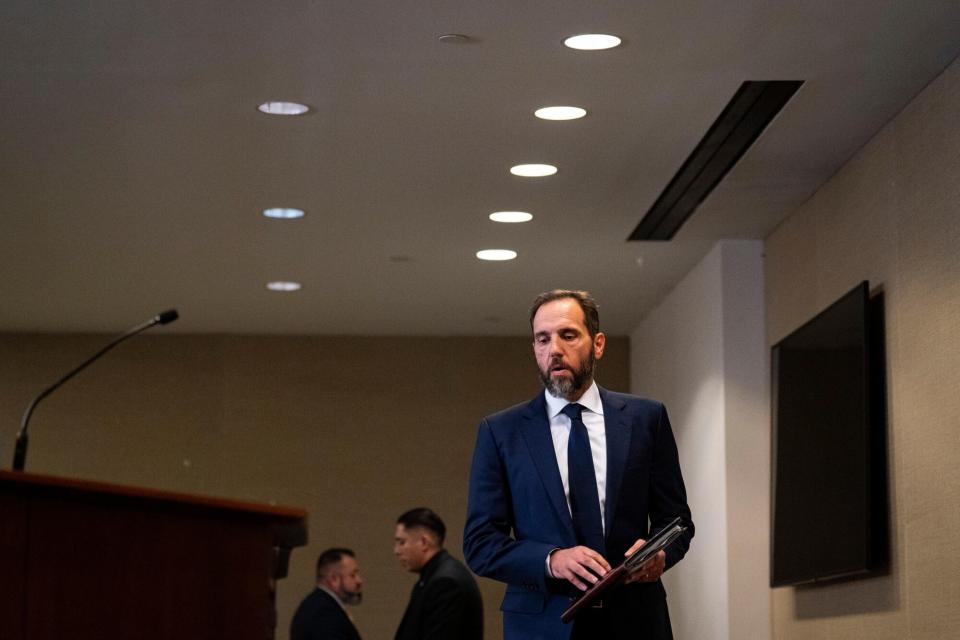Trump Indictment Showcases Enron-Era Law’s Use in Jan. 6 Cases
- Oops!Something went wrong.Please try again later.
(Bloomberg) -- The most serious charge in Donald Trump’s indictment for efforts to overturn the last presidential election has roots in the decades-old collapse of energy-trading giant Enron Corp. — and was revived recently as a key part of the Justice Department’s Jan. 6 prosecution playbook.
Most Read from Bloomberg
Fitch’s US Credit Downgrade Sparks Criticism Along With Unease
S&P 500 Has Worst Day Since April After Big Rally: Markets Wrap
Missing Goldman Sachs Analyst Confirmed Dead by New York Police
Here Are the 78 Charges Trump Now Faces, and All the Prison Time
The 2002 statute — corruptly obstructing an official proceeding — was drafted by Congress to address the conduct of Enron’s outside auditor, Arthur Andersen, which destroyed documents as the government investigated. Prosecutors have wielded the felony against Trump supporters they allege committed some of the most serious criminal acts during the Jan. 6, 2021, attack on the US Capitol.
Special Counsel Jack Smith’s decision to charge Trump with that offense amounts to a bet that challenges raised by Jan. 6 defendants convicted under the statute will continue to go nowhere as judges have consistently batted them down. While Trump could press similar arguments, his lawyers will have to contend with nearly two years of rulings about the same series of events from judges in the Washington court where he’s been indicted.
“I don’t think any of the defenses are likely to work,” said Randall Eliason, a former federal prosecutor in Washington and professor at George Washington University Law School who has written about the Jan. 6 fights over the law. “The statute squarely applies and that’s been the gist of the court decisions that have come down so far.”
Trump is accused of four felony counts in the grand jury indictment announced Tuesday, including one count of obstruction and one count of conspiring to commit obstruction. While the obstruction charges carry as much as 20 years in prison, Trump’s lack of past criminal history means he would likely face far less time if convicted.
Read More: Trump Faces Prospect of Up to Six Trials During Primary Season
Congress adopted the obstruction language Trump is charged under in the Sarbanes-Oxley Act of 2002. An earlier law criminalized persuading someone else to interfere with an investigation or official proceeding. But details about Arthur Andersen’s destruction of documents in the Enron investigation revealed a gap – the law didn’t offer a way to prosecute the party that actually carried out the destruction.
Much of the current version of the law, 18 USC 1512(c)(2), addresses tampering with evidence. But it also refers to any effort to “otherwise” corruptly obstruct an “official proceeding” – language the Justice Department has successfully argued applies to Jan. 6.
Defendants charged with the offense for participating in the Capitol attack have pushed for a narrower reading of the type of obstructive acts that fall under the law, arguing it shouldn’t apply to disrupting Congress’ certification of the election.
They’ve lost nearly all of these fights but are in various stages of appealing, leaving issues unsettled as the Trump prosecution unfolds. One set of cases is possibly headed to the US Supreme Court.
Trump was cited as an example of someone who might be more appropriately charged under the obstruction law in one pending appeal from a Jan. 6 defendant. The challenge from Thomas Robertson, a former Virginia police officer facing an 87-month sentence, focuses on how prosecutors prove someone acted “corruptly.”
“Looking back on January 6, there may well be persons who acted ‘corruptly’ – persons like President Donald Trump himself and his closest advisers, who were acting dishonestly, to benefit themselves,” Robertson’s attorney wrote in a December brief. “Robertson was not out to benefit himself. Any hope of benefit for President Trump was too remote from Robertson’s conduct to make this conduct criminally corrupt.”
A three-judge panel of the US Court of Appeals for the DC Circuit heard arguments in May and has yet to rule.
Other defendants have argued the law should be limited to obstruction involving records or other physical evidence. Federal judges in Washington presiding over the crush of Jan. 6 cases – prosecutors have charged more than 1,000 people to date – overwhelmingly rejected that interpretation, with one exception. US District Judge Carl Nichols, appointed under Trump, endorsed the defense position and dismissed the obstruction charge in several cases.
The DC Circuit reversed Nichols in April in a 2-1 decision. In an opinion written by Judge Florence Pan and joined by Judge Justin Walker – appointed by Biden and Trump, respectively – the court held that “the most natural reading” of the law was that it “applies to all forms of corrupt obstruction of an official proceeding.” Judge Greg Katsas, also appointed by Trump, dissented.
Defendants in those cases are petitioning the Supreme Court to intervene; one is already on the calendar for the justices to consider when they return from the summer break.
Eliason said that the charges in Trump’s case – he’s also accused of conspiring to defraud the US and to deprive people of their civil rights – offer different ways for prosecutors to tackle the same alleged crime: Trump’s efforts to overturn the 2020 election.
“Prosecutors love doing that, they love having alternative charges for their same theory,” he said. “Because then if one falls apart somehow, well, you’ve got the other ones.”
Most Read from Bloomberg Businessweek
Influencers Built Up This Wellness Startup—Until They Started Getting Sick
AI in Hollywood Has Gone From Contract Sticking Point to Existential Crisis
Amazon Unveils Biggest Grocery Overhaul Since Buying Whole Foods
Honoring the Enslaved Man Who Made Jack Daniel’s First Whiskey
Economist Behind Popular Recession Gauge Worries She Created a ‘Monster’
©2023 Bloomberg L.P.



